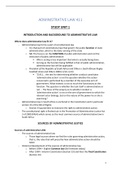Summary
Administrative Law 411 Summary
- Course
- Institution
- Book
The document contains a neat and comprehensive summary of all the coursework prescribed for the final year semester module, Administrative Law 411. The author of the notes placed within the top 10% of students in the module group and passed the module with a distinction.
[Show more]



